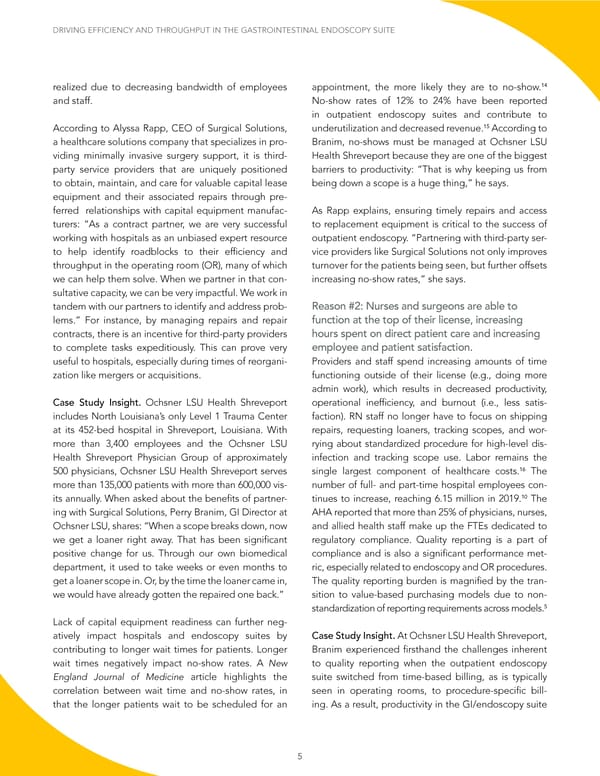DRIVING EFFICIENCY AND THROUGHPUT IN THE GASTROINTESTINAL ENDOSCOPY SUITE realized due to decreasing bandwidth of employees appointment, the more likely they are to no-show.14 and staff. No-show rates of 12% to 24% have been reported in outpatient endoscopy suites and contribute to 15 According to Alyssa Rapp, CEO of Surgical Solutions, underutilization and decreased revenue. According to a healthcare solutions company that specializes in pro- Branim, no-shows must be managed at Ochsner LSU viding minimally invasive surgery support, it is third- Health Shreveport because they are one of the biggest party service providers that are uniquely positioned barriers to productivity: “That is why keeping us from to obtain, maintain, and care for valuable capital lease being down a scope is a huge thing,” he says. equipment and their associated repairs through pre- ferred relationships with capital equipment manufac- As Rapp explains, ensuring timely repairs and access turers: “As a contract partner, we are very successful to replacement equipment is critical to the success of working with hospitals as an unbiased expert resource outpatient endoscopy. “Partnering with third-party ser- to help identify roadblocks to their efficiency and vice providers like Surgical Solutions not only improves throughput in the operating room (OR), many of which turnover for the patients being seen, but further offsets we can help them solve. When we partner in that con- increasing no-show rates,” she says. sultative capacity, we can be very impactful. We work in tandem with our partners to identify and address prob- Reason #2: Nurses and surgeons are able to lems.” For instance, by managing repairs and repair function at the top of their license, increasing contracts, there is an incentive for third-party providers hours spent on direct patient care and increasing to complete tasks expeditiously. This can prove very employee and patient satisfaction. useful to hospitals, especially during times of reorgani- Providers and staff spend increasing amounts of time zation like mergers or acquisitions. functioning outside of their license (e.g., doing more admin work), which results in decreased productivity, Case Study Insight. Ochsner LSU Health Shreveport operational inefficiency, and burnout (i.e., less satis- includes North Louisiana’s only Level 1 Trauma Center faction). RN staff no longer have to focus on shipping at its 452-bed hospital in Shreveport, Louisiana. With repairs, requesting loaners, tracking scopes, and wor- more than 3,400 employees and the Ochsner LSU rying about standardized procedure for high-level dis- Health Shreveport Physician Group of approximately infection and tracking scope use. Labor remains the 16 500 physicians, Ochsner LSU Health Shreveport serves single largest component of healthcare costs. The more than 135,000 patients with more than 600,000 vis- number of full- and part-time hospital employees con- its annually. When asked about the benefits of partner- tinues to increase, reaching 6.15 million in 2019.10 The ing with Surgical Solutions, Perry Branim, GI Director at AHA reported that more than 25% of physicians, nurses, Ochsner LSU, shares: “When a scope breaks down, now and allied health staff make up the FTEs dedicated to we get a loaner right away. That has been significant regulatory compliance. Quality reporting is a part of positive change for us. Through our own biomedical compliance and is also a significant performance met- department, it used to take weeks or even months to ric, especially related to endoscopy and OR procedures. get a loaner scope in. Or, by the time the loaner came in, The quality reporting burden is magnified by the tran- we would have already gotten the repaired one back.” sition to value-based purchasing models due to non- standardization of reporting requirements across models.5 Lack of capital equipment readiness can further neg- atively impact hospitals and endoscopy suites by Case Study Insight. At Ochsner LSU Health Shreveport, contributing to longer wait times for patients. Longer Branim experienced firsthand the challenges inherent wait times negatively impact no-show rates. A New to quality reporting when the outpatient endoscopy England Journal of Medicine article highlights the suite switched from time-based billing, as is typically correlation between wait time and no-show rates, in seen in operating rooms, to procedure-specific bill- that the longer patients wait to be scheduled for an ing. As a result, productivity in the GI/endoscopy suite 5
 Driving Efficiency & Throughput Page 5 Page 7
Driving Efficiency & Throughput Page 5 Page 7